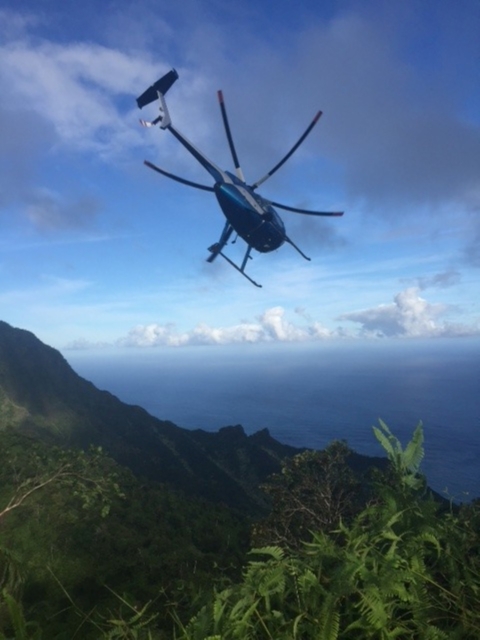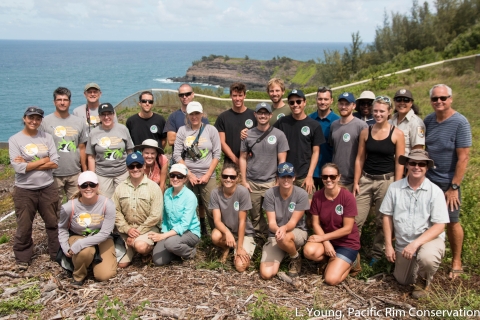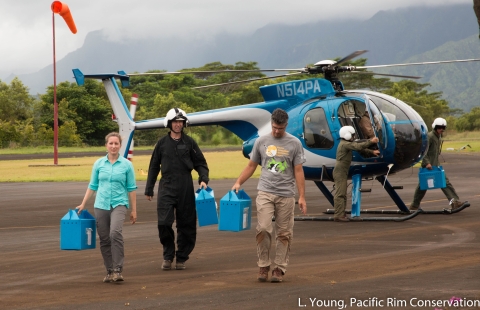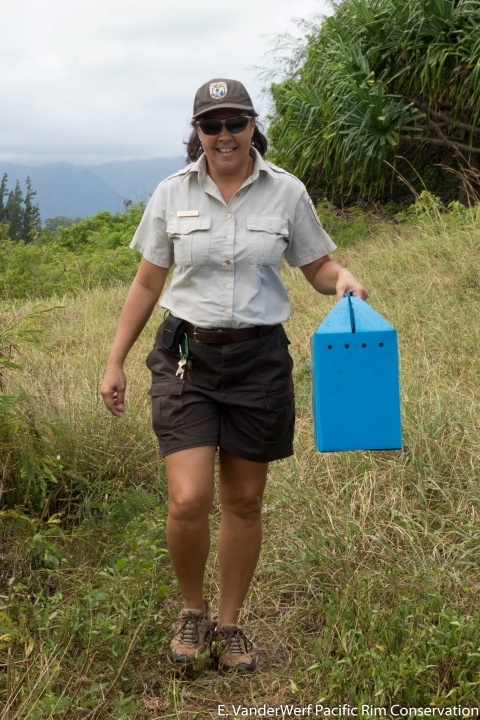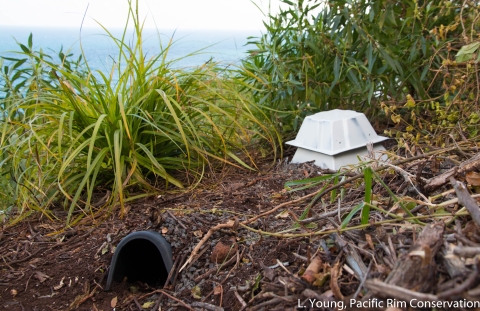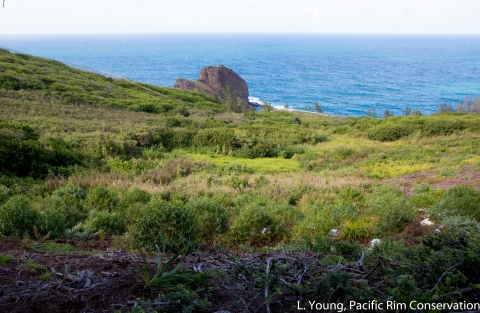This year is the 50th anniversary of the Endangered Species Act, a law that has been a powerful catalyst for conservation of America’s most treasured fish, wildlife, plants and their habitats. In the Pacific Region, our Tribes, state and federal agencies, and partners have joined with our dedicated staff to be the driving force behind the successes we share and the strength ensuring we can address the challenges ahead. Celebrate this milestone with us in this collection of stories as we reflect on past successes, assess current challenges, and envision an equally bright future for the next 50 years and beyond.
A project years in the making took place on Kauaʻi’s north shore on Monday when seven threatened Newell’s shearwater (‘a‘o) chicks were flown by helicopter from their montane nesting areas to a new colony protected by a predator-proof fence at Kīlauea Point National Wildlife Refuge. There they will be raised to fledging from the same site where 10 Hawaiian petrels were successfully translocated last year in the hopes of starting new colonies of both species.
The effort is a collaboration among the Kaua‘i Endangered Seabird Recovery Project (KESRP), Pacific Rim Conservation, American Bird Conservancy (ABC), the Hawaiʻi Department of Land and Natural Resources’ Division of Forestry and Wildlife (DOFAW), and the U.S. Fish and Wildlife Service. KESRP is a DOFAW/Pacific Cooperative Studies Unit project. Other partners also provided much-needed assistance for the project. The Kauaʻi Island Utility Cooperative provided critical support for predator control in collaboration with DOFAW at montane nesting areas within the Hono O Na Pali Natural Area Reserve and the National Tropical Botanical Garden (NTBG) at Upper Limahuli Preserve. NTBG also conducted vegetation restoration at Nihokū, where the fence is located in the refuge. The National Fish and Wildlife Foundation provided critical funding support.
“This project wouldn’t have been possible without the support of all the partners and we are very excited to see it go forward,” said Heather Tonneson, the U.S. Fish and Wildlife Service Kauaʻi National Wildlife Refuge Complex project leader. “The predator-proof fence area within the refuge will provide a safe haven for the shearwaters which, like many other native Hawaiian bird species, are facing tremendous challenges with shrinking habitat and the onslaught of invasive species invasive species
An invasive species is any plant or animal that has spread or been introduced into a new area where they are, or could, cause harm to the environment, economy, or human, animal, or plant health. Their unwelcome presence can destroy ecosystems and cost millions of dollars.
Learn more about invasive species .”
The translocation, which involved two separate teams and more than a dozen people, took place in Kauaʻi’s rugged mountain interior and along the coast. In the early morning, a team was dropped by helicopter onto a mountain peak located in the Upper Limahuli Preserve owned by NTBG. The team members headed out to seven different nest burrows that had been monitored throughout the breeding season. Seven large, healthy chicks were carefully removed from their burrows by hand, placed into pet carriers, and carried up the side of the mountain to a waiting helicopter. The chicks were flown to the Princeville airport, then driven to the refuge and their new home within the predator-proof fence. An eighth chick was found several weeks earlier in the Hono O Na Pali Natural Area Reserve, managed by DOFAW under their Native Ecosystem Protection & Management team, where it had left its burrow and become lost. It has been in care at the Save our Shearwaters facility and will join the other seven in a few days. Photos and videos of the translocation can be found on the U.S. Fish and Wildlife Service Pacific Region’s Flickr page at: http://bit.ly/NewHomeForSeabirds.
Threatened Newell’s shearwaters are one of two seabird species endemic to the Hawaiian Islands and are found nowhere else on earth. They have declined dramatically due to a number of factors including predation by introduced predators (such as cats, rats, pigs and barn owls) and collisions with man-made structures during nocturnal flights from their breeding colonies in the mountains to the ocean where they search for food. Surrounded by fine mesh stainless-steel fencing, 6.5 feet high, the 7.8-acre enclosure at Nihokū protects the birds from predators and has been partially restored with native vegetation. Seabird-friendly nest boxes, specifically designed to mimic natural burrows, have been installed.
“We are hopeful that translocation of this first group of chicks will mark the turning point in the downward trend for this species,” said Hannah Nevins, director of American Bird Conservancy’s Seabird Program. “The future of the Newell’s shearwater on Kaua‘i is dependent on multiple actions, from colony protection in the mountains to creating new predator-free colonies with fences, and continuing to mitigate light and collision impacts.”
Newell’s shearwater chicks imprint on their birth colony location the first time they emerge from their burrows and see the night sky, and will return to breed at the same colony as adults. Since chicks were removed from their natural burrows before this critical imprinting stage, the hope is that they will emerge from their nest boxes and imprint on the Nihokū area and return to the site as adults. In the meantime, they will be hand-fed a slurry of fish and squid, and their growth will be carefully monitored until they leave their new nest burrows and fly out to sea. They will remain at sea for the next 3 to 5 years. The new colony will be the only fully protected colony of this species anywhere in the Hawaiian Islands and represents a huge achievement toward recovering this species.
“Kaua‘i is home to an estimated 90 percent of the world population of Newell’s shearwater, so the island really is critical to the long-term survival of this species,” said Dr. André Raine of Kaua‘i Endangered Seabird Recovery Project. “Now is the time to focus all of our efforts on protecting the remaining colonies, using all the management strategies available to us, and establishing new colonies in protected areas like Nihokū. By using a diverse array of approaches, we hope to ensure that these beautiful birds will continue to grace our islands long into the future.”
“We are very excited to have accomplished a major recovery objective for one of Hawaiʻi’s endemic seabird species,” added Dr. Lindsay Young, the project coordinator with Pacific Rim Conservation. “What we learn on this project will be crucial to implementing what we hope will be many more projects like this on Kauaʻi and across the state.”
The Service completed an environmental assessment (EA) on ‘A‘o (Newellʻs shearwater) management actions in May of this year and a Finding of No Significant Impact (FONSI) for the EA has been issued. While this project will be the first translocation of Newell’s Shearwater chicks within Hawai‘i, translocation of closely related seabird species has been used with success in New Zealand in order to create new colonies, and this is the second year of testing this technique in Hawai‘i. It is hoped that similar outcomes will be achieved on Kaua‘i. The public was an important part of this process and the Service evaluated and responded to comments received on the EA. This information, the EA, and FONSI are now available for public review and may be found at Kīlauea Point National Wildlife Refuge.
###
The U.S. Fish and Wildlife Service works with others to conserve, protect, and enhance fish, wildlife, plants, and their habitats for the continuing benefit of the American people. For more information, visit www.fws.gov/pacificislands, or connect with us through any of these social media channels at https://www.facebook.com/PacificIslandsFWS, www.flickr.com/photos/usfwspacific/, https://medium.com/usfwspacificislands or www.twitter.com/USFWSPacific.

